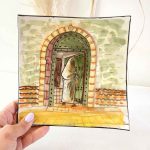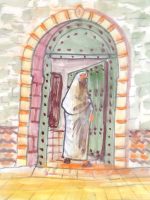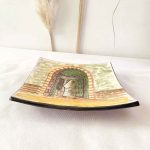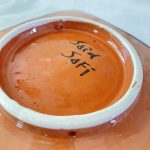Hand-painted Plate Woman in Marrakech
Morocco is known for its ceramics, covered in geometric patterns, arabesques, and beautiful designs.
Most Moroccan ceramic designs are heavily influenced by Islamic or Berber art. Intricate geometric patterns and arabesques tend to cover the entire surface of the pieces, completely transforming the humble clay building materials. Groups of artisans continue century-old traditions in their designs, passed down from parents to children.
How is Moroccan pottery made?
The process of making Moroccan pottery is a true labor of patience.
Moroccan ceramics are traditionally made from red clay which, in its solid form, contains minerals and eroded rocks. The rocks are first collected and crushed with a wooden hammer.
First, artisans soak the clay for 48 hours in water to soften it. They spread it on the ground to dry for another 48 hours.
Then, they mix the clay with their feet, knead it by hand to obtain homogeneous lumps. Afterward, artisans let the clay dry in the sun for several days.
Finally, after this painstaking work, the potter can start kneading the clay to make a ceramic item.
The modeling phase; During this phase, the clay is subject to hand force and rotation.
The artisan manipulates the clay by molding and turning it manually. They use sensitive gestures: their right hand and left hand work together to shape the clay on the cutter.
The artisan uses their perception of volumes to transform the mud into a jewel. The potter removes their work to place it on a table.
After giving it intricate shapes for vases, cups, tagines, plates, and more, the clay is allowed to dry for a few days before being baked in an oven. This changes the structure of the clay into ceramic material without fully fusing it.
Ceramics can be decorated before or after firing. This work also requires hours of patience, concentration, and application.
Then, each piece is hand-painted with the utmost precision, using multiple glazes to achieve the exact desired color and effect by the artist, who breathes life into intricate designs and vibrant colors!
Illustrations of Morocco’s nature and culture are a rich source of inspiration. The artist adds their personal touch to create a unique blend of colors and decorations.
Once decorated, the pieces are glazed and baked for a second time for 48 hours to obtain the finished product.



 Wool poufs
Wool poufs Vegan poufs
Vegan poufs







































